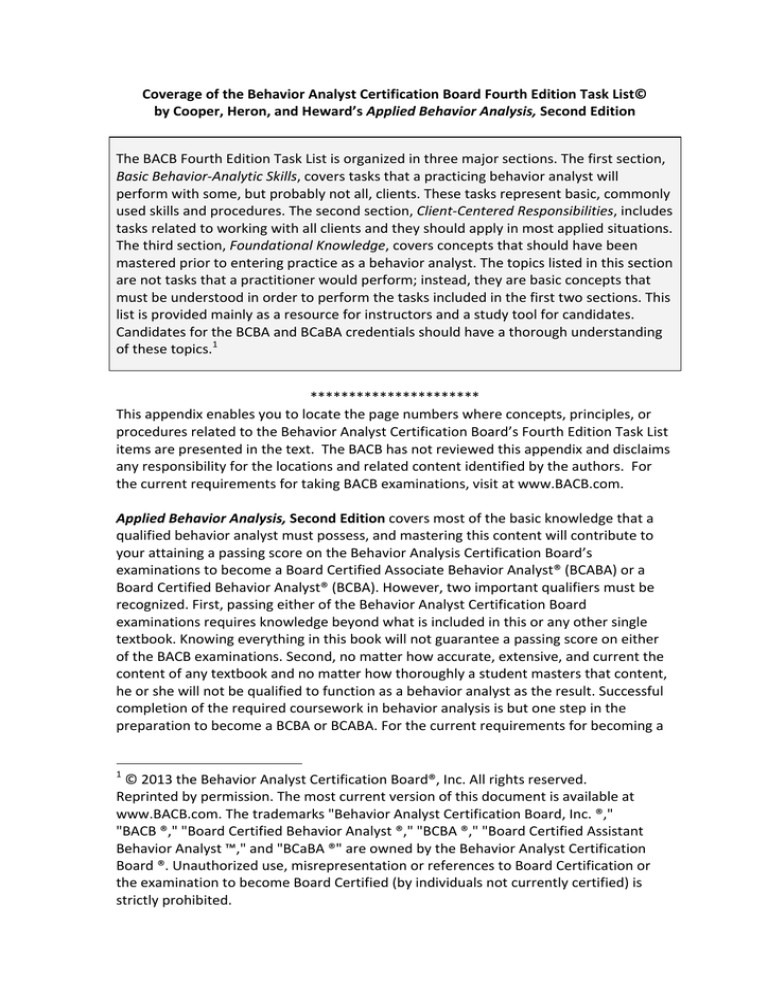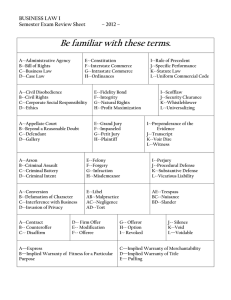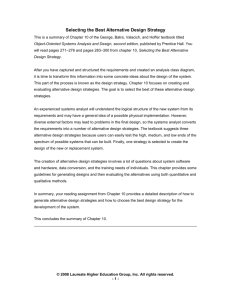Coverage of the Behavior Analyst Certification Board Fourth Edition
advertisement

Coverage of the Behavior Analyst Certification Board Fourth Edition Task List© by Cooper, Heron, and Heward’s Applied Behavior Analysis, Second Edition The BACB Fourth Edition Task List is organized in three major sections. The first section, Basic Behavior-­‐Analytic Skills, covers tasks that a practicing behavior analyst will perform with some, but probably not all, clients. These tasks represent basic, commonly used skills and procedures. The second section, Client-­‐Centered Responsibilities, includes tasks related to working with all clients and they should apply in most applied situations. The third section, Foundational Knowledge, covers concepts that should have been mastered prior to entering practice as a behavior analyst. The topics listed in this section are not tasks that a practitioner would perform; instead, they are basic concepts that must be understood in order to perform the tasks included in the first two sections. This list is provided mainly as a resource for instructors and a study tool for candidates. Candidates for the BCBA and BCaBA credentials should have a thorough understanding of these topics.1 ********************** This appendix enables you to locate the page numbers where concepts, principles, or procedures related to the Behavior Analyst Certification Board’s Fourth Edition Task List items are presented in the text. The BACB has not reviewed this appendix and disclaims any responsibility for the locations and related content identified by the authors. For the current requirements for taking BACB examinations, visit at www.BACB.com. Applied Behavior Analysis, Second Edition covers most of the basic knowledge that a qualified behavior analyst must possess, and mastering this content will contribute to your attaining a passing score on the Behavior Analysis Certification Board’s examinations to become a Board Certified Associate Behavior Analyst® (BCABA) or a Board Certified Behavior Analyst® (BCBA). However, two important qualifiers must be recognized. First, passing either of the Behavior Analyst Certification Board examinations requires knowledge beyond what is included in this or any other single textbook. Knowing everything in this book will not guarantee a passing score on either of the BACB examinations. Second, no matter how accurate, extensive, and current the content of any textbook and no matter how thoroughly a student masters that content, he or she will not be qualified to function as a behavior analyst as the result. Successful completion of the required coursework in behavior analysis is but one step in the preparation to become a BCBA or BCABA. For the current requirements for becoming a 1 © 2013 the Behavior Analyst Certification Board®, Inc. All rights reserved. Reprinted by permission. The most current version of this document is available at www.BACB.com. The trademarks "Behavior Analyst Certification Board, Inc. ®," "BACB ®," "Board Certified Behavior Analyst ®," "BCBA ®," "Board Certified Assistant Behavior Analyst ™," and "BCaBA ®" are owned by the Behavior Analyst Certification Board ®. Unauthorized use, misrepresentation or references to Board Certification or the examination to become Board Certified (by individuals not currently certified) is strictly prohibited. nd Cooper, Heron, & Heward’s ABA, 2 ed. th Coverage of BACB 4 Edition Task List -­‐ 2 of 11 BASIC BEHAVIOR-­‐ANALYTIC SKILLS A. Measurement Task A-­‐01 Measure frequency (i.e., count). A-­‐02 Measure rate (i.e., count per unit time). A-­‐03 Measure duration. A-­‐04 Measure latency. A-­‐05 Measure interresponse time (IRT). A-­‐06 Measure percent of occurrence. Textbook Content 75-­‐78, 85–87 (T 4.1), 88–89, 127 (F 6.1), 132 (F 6.4), 181 (F 8.4), 190 (F 8.10 & 8.11), 192 (F 8.12), 193 (F 8.13), 232 (F 10.3), 268 (F 11.6), 299 (F 12.6), 341 (F 14.6), 365 (F 15.4), 443 (F 20.5), 445 (F 20.7), 472 (F 22.1), 493 (F 23.3) 76–79, 85–87 (T 4.1), 127 (F 6.1), 129 (F 6.2), 133 (F 6.5), 140 (F 6.15), 142 (F 6.16), 182 (F 8.5), 265 (F 11.5), 272 (F 11.7), 281 (F 11.11), 301 (F 12.9), 308 (F 13.2), 328 (F 14.1), 334 (F 14.3), 336 (F 14.4), 340 (F 14.5), 345 (F 14.7), 359 (F 15.1), 365 (F 15.5), 460 (F 21.2), 463 (F 21.5), 474 (F 22.3), 475 (F 22.4), 478 (F 22.7), 481 (F 22.8), 489 (F 23.1), 490 (F 23.2) 79–80, 85–87 (T 4.1), 89–90, 133 (F 6.6), 317 (F 13.7), 459 (F 21.1) 75-­‐76 (F 4.1), 80, 85– 87 (T 4.1), 90, 99 80–81 (F 4.2), 85–87 (T 4.1), 90, 98, 479, 481– 484 81–82, 85–87 (T 4.1), 127 (F 6.1), 131 (F 6.3), 132 (F 6.4), 134 (F 6.7), 135 (F 6.8), 136 (F 6.9), 145 (F 6.18), 183 (F 8.6), 187 (F 8.8), 194 (F nd Cooper, Heron, & Heward’s ABA, 2 ed. A-­‐07 A-­‐08 A-­‐09 A-­‐10 A-­‐11 Measure trials to criterion. Assess and interpret interobserver agreement. Evaluate the accuracy and reliability of measurement procedures. Design, plot, and interpret data using equal-­‐interval graphs. Design, plot, and interpret data using a cumulative record to display data. A-­‐12 Design and implement continuous measurement procedures (e.g., event recording). A-­‐13 Design and implement discontinuous measurement procedures (e.g., partial & whole interval, momentary time sampling). A-­‐14 Design and implement choice measures. B. Experimental Design Task B-­‐01 Use the dimensions of applied behavior analysis (Baer, Wolf, & Risley, 1968) to evaluate whether interventions are behavior analytic in nature. B-­‐02 Review and interpret articles from the behavior-­‐ analytic literature. B-­‐03 B-­‐04 th Coverage of BACB 4 Edition Task List -­‐ 3 of 11 Systematically arrange independent variables to demonstrate their effects on dependent variables. Use withdrawal/reversal designs. 8.14 & 8.15), 231 (F 10.2), 241 (F 10.6), 257 (F 11.1), 274 (F 11.8), 298 (F 12.5), 300 (F 12.7), 314 (F 13.6), 318 (F 13.8), 336 (F 14.4), 347 (F 14.8), 359 (F 15.2), 395 (F 17.1), 444 (F 20.6), 446 (F 20.8), 461 (F 21.3), 474 (F 22.3), 477 (F 22.6), 490 (F 23.2), 495 (F 23.5) 82–83, 85–87 (T 4.1) 113-­‐122 94–98, 103–124 129–138, 144–157, 247, 249 135–139, 192 (F 8.12), 268 (F 11.6), 297 (F 12.4), 299 (F 12.6) 88-­‐90, 95-­‐98 90-­‐95 275-­‐283, 520 Textbook Content 16-­‐18, 235, 247-­‐252 149–155, 230–252 (see discussions that accompany graphs throughout text) 5-­‐6, all of Chapters 7– 10, 504–506 129 (F 6.2), 167–174, 172–173 (F 7.4 & 7.5), 177–187, 229–231 (F 10.2), 257 (F 11.1), 265 (F 11.5), 274 (F 11.8), 328 (F 14.1), 341 (F 14.6), 347 (F 14.8), 366 (F 15.7), 460 (F 21.2), 461 (F 21.3), 472 (F nd Cooper, Heron, & Heward’s ABA, 2 ed. B-­‐05 Use alternating treatments (i.e., multielement) designs. B-­‐06 Use changing criterion designs. B-­‐07 Use multiple baseline designs. B-­‐08 B-­‐09 Use multiple probe designs. Use combinations of design elements. B-­‐10 Conduct a component analysis to determine the effective components of an intervention package. B-­‐11 Conduct a parametric analysis to determine the effective values of an independent variable. C. Behavior-­‐Change Considerations Task C-­‐01 State and plan for the possible unwanted effects of reinforcement. C-­‐02 State and plan for the possible unwanted effects of punishment. C-­‐03 State and plan for the possible unwanted effects of extinction. D. Fundamental Elements of Behavior Change Task D-­‐01 Use positive and negative reinforcement. th Coverage of BACB 4 Edition Task List -­‐ 4 of 11 22.1), 477 (F 22.6), 478 (F 22.7), 592 (F 27.3), 647 (F 28.10) 133 (F 6.5), 187–197, 230–232 (F 10.3), 299 (F 12.6), 314 (F 13.6), 365 (F 15.5), 475 (F 22.4), 516 (F 24.4), 518 (F 24.5), 519 (F 24.6), 522 (F 24.9) 219–223, 308 (F 13.2), 430 (F 19.5) 131–132 (F 6.3 & 6.4), 201–219, 272 (F 11.7), 301 (F 12.8), 317 (F 13.7), 336 (F 14.4), 359 (F 15.1), 365 (F 15.4), 423 (F 19.2), 443 (F 20.5) 445 (F 20.7), 489 (F 23.1), 490 (F 23.2), 493 (F 23.3), 495 (F 23.5), 553 (F 26.2), 555 (F 26.3), 561 (F 26.8), 570 (F 26.12), 594 (F 27.4), 602(F 27.7), 629 (F 28.5), 630 (F 28.6), 645 (F 28.9) 209-­‐212, 444 (F 20.6) 229-­‐230, 232 (F 10.3), 298 (F 12.5), 299 (F 12.6), 365 (F 15.5 & F 15.5) 162, 166, 230, 359 (F 15.2) 166, 340 (F 14.5), 474 (F 22.3), 483 (F 22.9) Textbook Content 36, 266–267, 302, 641 37–38, 336–338, 349, 370–371 461–463, 466–467 Textbook Content 36-­‐37, 42 (F 2.3), 257– nd Cooper, Heron, & Heward’s ABA, 2 ed. D-­‐02 Use appropriate parameters and schedules of reinforcement. D-­‐03 Use prompts and prompt fading. D-­‐04 D-­‐05 D-­‐06 D-­‐07 Use modeling and imitation training. Use shaping. Use chaining. Use task analysis. D-­‐08 Use discrete-­‐trials and free-­‐operant arrangements. D-­‐09 D-­‐10 D-­‐11 Use verbal operants as a basis for language assessment. Use echoic training. Use mand training. D-­‐12 Use tact training. D-­‐13 Use intraverbal training. D-­‐14 D-­‐15 D-­‐16 Use listener training. Use positive and negative punishment. Identify and use punishers. D-­‐17 Use appropriate parameters and schedules of punishment. Use extinction. Use combinations of reinforcement with punishment and extinction. D-­‐18 D-­‐19 D-­‐20 Use response-­‐independent (time-­‐based) schedules of reinforcement (i.e., noncontingent reinforcement). D-­‐21 Use differential reinforcement (e.g., DRO, DRA, DRI, DRL, DRH). E. Specific Behavior-­‐Change Procedures Task E-­‐01 Use interventions based on manipulation of antecedents, such as motivating operations and discriminative stimuli. E-­‐02 Use discrimination training procedures. E-­‐03 Use instructions and rules. th Coverage of BACB 4 Edition Task List -­‐ 5 of 11 303, 463–464, 599– 604, 635–642 280–283, 287-­‐289, 305, 323, 636–640, 646–648 287, 401–408, 417– 418, 426, 495 402, 413–419 421–433 435–453, 589 437–441, 444–446, 450 77-­‐78, see Chapters 11-­‐23, 25-­‐28 540-­‐541 531, 543–544 193–194, 530, 541– 543 530, 536–537, 539– 540, 544–545 531-­‐532, 538–539, 545–546 529-­‐533, 539-­‐541 327–355, 357-­‐371 37–41, 42 (F 2.3), 327– 355, 357-­‐371 332-­‐336, 361-­‐363, 369-­‐371 457–468 334-­‐336, 342-­‐343, 348-­‐349, 362, 367-­‐ 370, 465 182–184, 284, 489– 492 284–285, 314–315, 421–422, 470–485 Textbook Content 41-­‐42, 375–391, 393– 409, 487-­‐497, 587– 590, 644–646 395-­‐396, Chapter 17 260, 428, 465, 552-­‐ 553, 604–605, 648 nd Cooper, Heron, & Heward’s ABA, 2 ed. E-­‐04 Use contingency contracting (i.e., behavioral contracts). E-­‐05 Use independent, interdependent, and dependent group contingencies. E-­‐06 Use stimulus equivalence procedures. E-­‐07 Plan for behavioral contrast effects. E-­‐08 Use the matching law and recognize factors influencing choice. E-­‐09 Arrange high-­‐probability request sequences. E-­‐10 Use the Premack principle. E-­‐11 Use pairing procedures to establish new conditioned reinforcers. E-­‐12 Use errorless learning procedures. E-­‐13 Use matching-­‐to-­‐sample procedures. F. Behavior-­‐Change Systems Task F-­‐01 Use self-­‐management strategies. F-­‐02 Use token economies and other conditioned reinforcement systems. F-­‐03 Use Direct Instruction. F-­‐04 Use precision teaching. F-­‐05 F-­‐06 F-­‐07 F-­‐08 th Coverage of BACB 4 Edition Task List -­‐ 6 of 11 Use personalized systems of instruction (PSI). Use incidental teaching. Use functional communication training. Use augmentative communication systems. 551–559 567–573 398-­‐401 337-­‐338 318-­‐319 492-­‐494 271–273, 277 40-­‐41, 269-­‐270 403-­‐408 398-­‐401 Textbook Content 576-­‐612, 646, 648-­‐650 560-­‐567 Not covered Standard Celeration Charts used by precision teachers: 139–144 Not covered 542, 634 494-­‐496 Not covered CLIENT-­‐CENTERED RESPONSIBILITIES G. Identification of the Problem Task G-­‐01 Review records and available data at the outset of the case. G-­‐02 Consider biological/medical variables that may be affecting the client. G-­‐03 Conduct a preliminary assessment of the client in order to identify the referral problem. G-­‐04 Explain behavioral concepts using nontechnical language. G-­‐05 Describe and explain behavior, including private events, in behavior-­‐analytic (non-­‐mentalistic) terms. G-­‐06 Provide behavior-­‐analytic services in collaboration with others who support and/or provide services to one’s clients. Textbook Content 55-­‐65, 624-­‐625, 666 (F 29.4), 675 Not covered 49-­‐56, 62-­‐65, 510-­‐511 Not covered 7, 9-­‐14, 25-­‐46, 260-­‐ 269, 537-­‐538, 599-­‐600 641-­‐642, 675-­‐676 nd Cooper, Heron, & Heward’s ABA, 2 ed. G-­‐07 Practice within one’s limits of professional competence in applied behavior analysis, and obtain consultation, supervision, training, or make referrals as necessary. G-­‐08 Identify and make environmental changes that reduce the need for behavior analysis services. H. Measurement Task H-­‐01 Select a measurement system to obtain representative data given the dimensions of the behavior and the logistics of observing and recording. H-­‐02 Select a schedule of observation and recording periods. H-­‐03 Select a data display that effectively communicates relevant quantitative relations. H-­‐04 Evaluate changes in level, trend, and variability. H-­‐05 Evaluate temporal relations between observed variables (within & between sessions, time series). I. Assessment Task I-­‐01 Define behavior in observable and measurable terms. I-­‐02 Define environmental variables in observable and measurable terms. I-­‐03 Design and implement individualized behavioral assessment procedures. I-­‐04 Design and implement the full range of functional assessment procedures. I-­‐05 Organize, analyze, and interpret observed data. I-­‐06 Make recommendations regarding behaviors that must be established, maintained, increased, or decreased. Design and conduct preference assessments to identify putative reinforcers. I-­‐07 J. Intervention Task J-­‐01 State intervention goals in observable and measurable terms. J-­‐02 Identify potential interventions based on th Coverage of BACB 4 Edition Task List -­‐ 7 of 11 665-­‐668 18, 21, 167, 581-­‐583 Textbook Content 5, 11, 16-­‐19, 73-­‐101, 248 (F 10.8) 73-­‐101, 106-­‐108, 248 (F 10.8) 127-­‐157 78, 149-­‐155, 161-­‐162, 227-­‐228, 247 Chapters 6-­‐10 Textbook Content 3, 5, 16, 25-­‐27, 65-­‐69, 160-­‐162 27-­‐28, 38-­‐42, 55, 65-­‐ 66, 235-­‐237 49-­‐71, 300, 335-­‐336, 364-­‐366, 457, 459-­‐ 460, 499-­‐524 178-­‐179 (F 8.3), 300, 335-­‐336, 364-­‐366, 457, 459-­‐460, 501-­‐524 Chapters 6-­‐10 55-­‐65, 237-­‐238 36, 274-­‐283, 551, 556-­‐ 558 (F 26.6), 563, 635-­‐ 642 Textbook Content 55-­‐56, 65-­‐69 55-­‐65, 237-­‐240, 513-­‐ nd Cooper, Heron, & Heward’s ABA, 2 ed. J-­‐03 J-­‐04 J-­‐05 J-­‐06 J-­‐07 J-­‐08 J-­‐09 J-­‐10 J-­‐11 J-­‐12 J-­‐13 J-­‐14 J-­‐15 assessment results and the best available scientific evidence. Select intervention strategies based on task analysis. Select intervention strategies based on client preferences. Select intervention strategies based on the client’s current repertoires. Select intervention strategies based on supporting environments. Select intervention strategies based on environmental and resource constraints. Select intervention strategies based on the social validity of the intervention. Identify and address practical and ethical considerations when using experimental designs to demonstrate treatment effectiveness. When a behavior is to be decreased, select an acceptable alternative behavior to be established or increased. Program for stimulus and response generalization. Program for maintenance. Select behavioral cusps as goals for intervention when appropriate. Arrange instructional procedures to promote generative learning (i.e., derived relations). Base decision-­‐making on data displayed in various formats. K. Implementation, Management, and Supervision Task K-­‐01 Provide for ongoing documentation of behavioral services. K-­‐02 K-­‐03 th Coverage of BACB 4 Edition Task List -­‐ 8 of 11 523, 623-­‐624 437-­‐441, 444-­‐446 55-­‐65, 193, 237-­‐239, 557 (F 26.6), 674 55-­‐65 55-­‐65, 623-­‐624, 652 240 (F 10.5), 250, 652, 674-­‐676 237-­‐240, 250, 623-­‐ 624, 661 168-­‐169, 180, 182, 185-­‐187, 195-­‐197, 217-­‐219, 222-­‐223 348-­‐349, 470-­‐485, 494-­‐496 615-­‐655 615-­‐617, 619-­‐620, 623-­‐624, 635-­‐653 58-­‐59 398-­‐400 120-­‐122, 127-­‐128, 149-­‐155, 167-­‐173, 177-­‐197, 201-­‐223, 504-­‐524 (see discussions that accompany graphs throughout text) Textbook Content 675 (see discussions that accompany graphs throughout text) Identify the contingencies governing the behavior of 235-­‐236, 603-­‐604, those responsible for carrying out behavior-­‐change 607-­‐609, 652, 659-­‐678 procedures and design interventions accordingly. Design and use competency-­‐based training for 108-­‐110, 236 persons who are responsible for carrying out behavioral assessment and behavior-­‐change procedures. nd Cooper, Heron, & Heward’s ABA, 2 ed. K-­‐04 K-­‐05 K-­‐06 K-­‐07 K-­‐08 K-­‐09 K-­‐10 th Coverage of BACB 4 Edition Task List -­‐ 9 of 11 Design and use effective performance monitoring and reinforcement systems. Design and use systems for monitoring procedural integrity. Provide supervision for behavior-­‐change agents. Evaluate the effectiveness of the behavioral program. Not covered 235-­‐237 Not covered 6-­‐7, 17-­‐18, 23, Chapters 7-­‐10 (see discussions that accompany graphs throughout text) Establish support for behavior-­‐analytic services from Not covered direct and indirect consumers. Secure the support of others to maintain the client’s 641-­‐642, 652 behavioral repertoires in their natural environments. Arrange for the orderly termination of services 565-­‐566, 648-­‐650, 672 when they are no longer required. (F 29.7), 673 (F 29.8) FOUNDATIONAL KNOWLEDGE ACCOMPANYING THE BACB FOURTH EDITION TASK LIST Explain and Behave in Accordance with the Philosophical Assumptions of Behavior Analysis Task Textbook Content FK-­‐01 Lawfulness of behavior 25-­‐46, 160-­‐162 FK-­‐02 Selectionism (phylogenic, ontogenic, cultural) 32, 34, 36, 43 FK-­‐03 Determinism 5, 22, 159,161 FK-­‐04 Empiricism 5, 22, 159 FK-­‐05 Parsimony 6, 22, 159 FK-­‐06 Pragmatism 19, 22 FK-­‐07 Environmental (as opposed to mentalistic) 10-­‐14, 27-­‐28, 32-­‐34, explanations of behavior 40-­‐45, 159-­‐162 FK-­‐08 Distinguish between radical and methodological 11-­‐14, 537 behaviorism. FK-­‐09 Distinguish among the conceptual analysis of 20, 21 (F 1.2) behavior, experimental analysis of behavior, applied behavior analysis, and behavioral service delivery. Define and Provide Examples of: Task Textbook Content FK-­‐10 behavior, response, response class 25–27, 34, 429–430, 620–621 FK-­‐11 environment, stimulus, stimulus class 27–29, 41, 393–397 FK-­‐12 stimulus equivalence 398-­‐400, 622 FK-­‐13 reflexive relations (US-­‐UR) 10, 29-­‐31 (T 2.2, F 2.1) FK-­‐14 respondent conditioning (CS-­‐CR) 29–31 (F 2.1), 33 (T 2.3), 393, 606 FK-­‐15 operant conditioning 31–36 (T 2.3) nd Cooper, Heron, & Heward’s ABA, 2 ed. FK-­‐16 FK-­‐17 FK-­‐18 FK-­‐19 FK-­‐20 FK-­‐21 FK-­‐22 th Coverage of BACB 4 Edition Task List -­‐ 10 of 11 33 (T 2.3) 38-­‐40, 269-­‐270, 295 40-­‐41, 269-­‐270, 295 39-­‐40, 331-­‐332 40-­‐41, 331-­‐332 305-­‐323, 333-­‐334 30–31 (F 2.1), 37, 283– 285, 457–468 FK-­‐23 automatic reinforcement and punishment 267-­‐269, 460, 490, 502, 534, 536, FK-­‐24 stimulus control 35, 41–42, 261, 393– 409, 589–590 FK-­‐25 multiple functions of a single stimulus 28, 382-­‐384 (T 16.3) FK-­‐26 unconditioned motivating operations 377-­‐381 FK-­‐27 conditioned motivating operations 384-­‐389 FK-­‐28 transitive, reflexive, surrogate motivating operations 384-­‐388, 390-­‐391 FK-­‐29 distinguish between the discriminative stimulus and 375-­‐377, 382, 385-­‐ the motivating operation 389, 394 FK-­‐30 distinguish between motivationing operation and 39, 261, 263-­‐265, 375-­‐ reinforcement effects 391 FK-­‐31 behavioral contingencies 35, 41–42, 258–259, 261, 263–265, 292– 294, 331 (F 14.2) FK-­‐32 contiguity 42 FK-­‐33 functional relations 4–6, 17, 38–39, 167– 174, 177–179, 188– 191, 201–204, 219– 221, 230–237 FK-­‐34 conditional discriminations 398, 400-­‐401 (F 17.6) FK-­‐35 stimulus discrimination 394-­‐400, 408 FK-­‐36 response generalization 250-­‐251, 620-­‐622 FK-­‐37 stimulus generalization 394-­‐396 (F 17.1), 616, 632 FK-­‐38 behavioral contrast 337-­‐338, 349 FK-­‐39 behavioral momentum 493 FK-­‐40 matching law 318-­‐319 (F 13.8) FK-­‐41 contingency-­‐shaped behavior 31-­‐42 FK-­‐42 rule-­‐governed behavior 260, 552-­‐553 (F 26.2), 573 Distinguish between Verbal and Nonverbal Operants Task Textbook Content FK-­‐43 Echoics 412–419, 529, 531, 543–544 FK-­‐44 Mands 193–194, 529-­‐530, 540–543 FK-­‐45 Tacts 529, 530, 536–537, respondent-­‐operant interactions unconditioned reinforcement conditioned reinforcement unconditioned punishment conditioned punishment schedules of reinforcement and punishment extinction nd Cooper, Heron, & Heward’s ABA, 2 ed. FK-­‐46 Intraverbals Measurement Concepts Task FK-­‐47 Identify the measurable dimensions of behavior (e.g., rate, duration, latency, inter-­‐response time). FK-­‐48 State the advantages and disadvantages of using continuous measurement procedures and discontinuous measurement procedures (e.g., partial-­‐ and whole-­‐interval recording, momentary time sampling). th Coverage of BACB 4 Edition Task List -­‐ 11 of 11 539–540, 544–545 529, 531-­‐532, 538– 539, 545–546 Textbook Content 73, 76-­‐82, 855-­‐86 (T 4.1), 423 (T 19.1) 90-­‐94, 106-­‐107



